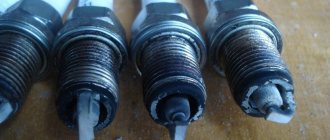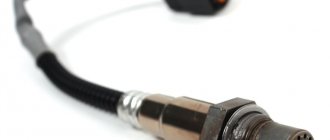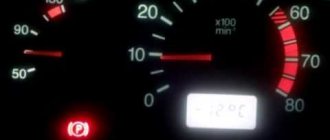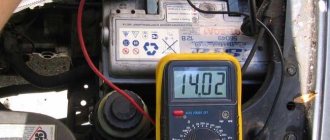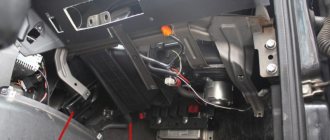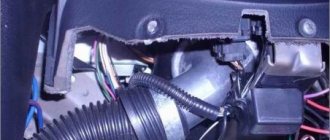Causes of the smell of gasoline
If the smell of fuel does not disappear even after several kilometers from the gas station, then the reason may be that the fuel tank cap is not sealed properly.
. Make sure it is in place, securely tightened, and in serviceable condition. Because when the rubber seal is cracked or dried out, it should be replaced.
The cover is ok and you drive on, but the smell still doesn't leave the car's interior? Check to see if your windows are closed, maybe the smell is coming from the exhaust pipe
(due to incomplete combustion of fuel). It can get into windows and the car ventilation system.
There are no problems with exhaust gases either, then inspect the bottom of the car, there may be a leak somewhere in the fuel line
. Leaks or leaks in the gas tank or fuel pipes occur due to a violation of the integrity and at the joints. A leak can be caused by corrosion (especially in metal tanks), and occurs due to mechanical damage or loosening of the clamp attached to the pipes.
In addition to these three main problems, there may of course be others, but much less frequently. However, so that you can check, because perhaps this is exactly your case, I will list a few more possible situations:
The absorber filter is clogged, there is a crack between the neck and the tank, the fuel supply is disrupted (carburetor failure or injector failure).
Traditional methods for eliminating fuel odors
Now a little about how to remove the smell of fuel from the cabin on your own. Of course, it is advisable to replace worn out or worn out elements and parts with new ones. But, if you can’t do this right away for some reason, you can use proven tips. Take some laundry soap and warm water. Based on them, we make a solution, the concentration of soap in which should be quite high. Minor and small cracks can be repaired in this way. Of course, it cannot be said that it is worth repairing all the damage in this way, especially since it is difficult to call it a radical solution to the problem. But in those situations when a leak appears suddenly and you need to get to the nearest car mechanic, he will serve as a good assistant.
Where does gasoline come from in the cabin?
The cause of the smell is gasoline fumes penetrating into the cabin. There are more than enough ways for them to get in - the car interior has many ventilation holes. The success in troubleshooting and troubleshooting largely depends on determining where vapors penetrate into the cabin.
There are 2 main reasons why the smell of gasoline occurs:
- Fuel system malfunction. It consists of many different components, damage to which not only causes a persistent gasoline smell both inside and outside the car, but can also cause a fire.
- Exhaust system malfunction. Exhaust gases entering the cabin may also have a strong gasoline odor.
In any case, if such aromas occur, it is necessary to urgently begin to identify the malfunction. It is worth noting that gasoline vapors are poisonous, and their inhalation provokes a decrease in reaction and hallucinations. The manifestation of symptoms of poisoning in a car driver can cause a serious accident.
Why does my car smell like gasoline?
We will consider the reasons that may arise immediately after repair or unexpectedly in any situation, regardless of the conditions of starting the car or visiting a gas station.
Leaky connections of the fuel level sensor
One of the most common reasons for the smell of gasoline in a car is leaking joints in the fuel system. This defect is most relevant for VAZs with front-wheel drive. The peculiarity of these cars is that the fuel system connection is located under the rear seat. To perform the check, you need to lift the rear seat cushion and fold down the inspection hatch. After this, you need to tighten all the threaded connections that relate to the fuel line.
Wear of the fuel pump inspection hatch
This situation is relevant for cars equipped with injection engines. They have a cap fixed on the gasoline tank, to which the fuel pump and fuel level sensor are attached, located inside the gas tank. The lid is held on the tank with screws, and a sealing material is placed directly under the lid. It is this that becomes unusable over time and begins to leak gasoline vapors.
The carburetor is not adjusted correctly
Cars equipped with a carburetor engine can consume much more fuel. The reason lies in an incorrectly configured carburetor. Excess fuel does not burn, but ends up under the hood, the residue evaporates and has a strong, specific smell of gasoline. The smell penetrates into the interior of the car, especially in the cold season when the stove is running.
Owners of carburetor cars usually use a choke (to increase the amount of gasoline in the carburetor) to start the engine more gently. In such a situation, you can easily make a mistake and supply excess gasoline - its smell will certainly get into the cabin.
Separator
There are models of vehicles from the domestic automobile industry that are equipped with a so-called gas tank separator. Its design is extremely simple and effective: it is a small sealed plastic container mounted above the neck of the gas tank. The main function of the separator is to equalize the pressure in the gas tank. Gasoline vapors settle on the inner surface of the container and fall back into the tank. For greater efficiency, the separator uses a two-way valve.
The container of the separator itself is made of durable plastic, but sometimes a crack forms on the body under the influence of various unfavorable factors. This leads to the fact that gasoline vapors can enter the car interior.
Clogged catalyst
An automobile catalyst performs the function of afterburning the exhaust with remaining gasoline to the required state of inert gas. Over time, due to constant use or fatigue, the carburetor stops performing its tasks and begins to pass gasoline vapors through the entire system. This way, fumes enter the environment and can easily enter the cabin through the ventilation system.
Rear door seal
Modern cars are equipped with fuel tanks, the neck of which is located on one side of the rear of the body; car enthusiasts call this place “rear fenders”. When refueling a car, a small amount of gasoline vapor enters the atmosphere; if the seal on the rear passenger door, where the fuel tank is located, has defects and allows air into the cabin, then there is a high probability that there is a strong smell of gasoline in the car interior.
Gasoline getting into the cabin
This is a fairly simple and obvious reason that occurs when gasoline is transported in metal cans in the passenger compartment or trunk of a car. If the cap seal requires replacement and there is a fuel leak or there are gasoline residues on the body of the canister itself, even a small amount will be enough to fill the car interior with a strong smell of gasoline. The reason is obvious, just eliminate the source and the problem will be solved.
Poor quality gasoline
Unfortunately, sometimes you have to refuel with low-quality gasoline. Then the most likely situation is that the remains of unused gasoline enter the environment and spread both around the car and inside. Spark plugs tell you about the quality of gasoline. If you unscrew the spark plug and see that its lower part is covered with red soot, you can say with 100% certainty that you filled in low-quality gasoline.
It should also be noted that the use of bad gasoline negatively affects the general condition of the entire fuel system. Choose only gas stations of proven and reliable operators, refuel where they value their customers and the company’s image.
Save the people, it smells like gasoline
In general, this morning I noticed that there was a completely unnoticeable smell of gasoline in the cabin.
I drove all day...on the wretched roads of Churkin (I hit the bottom of the car a couple of times, but only slightly) But in the evening, when I parked the car, I discovered that in the area of the rear wheel arch (on the left) there was a terrible stench of gasoline, as if the entire wheel and arch were doused with it. The gas tank inlet is closed and there is no smell at all. There is also no smell from the other wheel arches, only from the rear left one. The car sat for about 2 hours, the smell remained insignificant at all. Someone said that it was a muffler - but the muffler is on the right, there is no smell of anything in the rear wheel arch on the right.Who thinks about this?
The smell of gasoline in the car interior - possible consequences
Cars VAZ-2101-2105, VAZ-2106 and VAZ-2107 are morally and technically becoming obsolete, which allows us to safely classify them as “classics”. And, despite knowledge of the design and maintenance experience, the problem with the smell of gasoline in the interior of such cars is becoming more and more common.
Injection models are also not left out, the fuel system of which is also far from ideal.
Before considering the reasons for the smell of gasoline, we will analyze the likely risks and consequences of such a malfunction.
There are several of them:
- INCREASED FUEL CONSUMPTION. Often the appearance of odor is associated with a leak in one of the elements of the fuel system. As a result, most of the gasoline will remain on the asphalt or elements of the car body.
- RISK OF FIRE. The main danger of fuel is its tendency to ignite. A small spark is enough for the gasoline vapor to ignite along with the car. There is no need to remind you about the consequences again.
- HARM TO THE BODY. Gasoline vapors, despite their pleasant aroma, are dangerous to the respiratory system and the body as a whole. Prolonged inhalation of fuel vapors leads to dizziness, nausea and even loss of consciousness. In addition, long-term exposure to vapors may result in poor health and even death.
That is why, when the first smell of gasoline appears, you should act without delay, regardless of the make of the car - be it Lanos, VAZ-2107, Niva and other cars.
How to remove smell from the interior?
It is difficult to get rid of the unpleasant smell of fuel in the cabin. However, there are several effective methods, which will be discussed below.
Flavors
How to remove the smell of gasoline in a car for a long time? To make your car always smell nice, you can use fragrances. They come in different scents. It all depends on your preferences. They also help neutralize gasoline aroma. The main thing is not to use several scents at the same time.
Interior dry cleaning
The most effective method is dry cleaning. However, this is an expensive procedure. First, the interior needs to be vacuumed and then treated with a special solution. He will clean and disinfect the car. Afterwards, a special foam is applied and the fabric upholstery is dried.
Ozone interior cleaning
The essence of the method is to use a generator containing ozone molecules inside. They effectively remove unpleasant odors. The main advantage of ozone cleaning is the destruction of mold and bacteria. After the procedure, a pleasant smell will linger in the salon for a long time.
Shampoo wash
- Some motorists wash the interior with car shampoo.
- The product is applied to the upholstery, cleaned with a brush, and washed off with water.
- If necessary, repeat the procedure.
Soda
- First, sprinkle baking soda on the gasoline stains.
- The product must be left for 24 hours.
- Afterwards, vacuum the interior.
- Within a day the unpleasant smell will disappear.
Vinegar
This substance helps cope with unpleasant odors. Prepare a vinegar solution (1 liter of vinegar per 2 liters of water) and spray the product throughout the cabin. A spray bottle or spray bottle will help. Afterwards you need to check the car within 3-4 hours.
Coffee
An effective way to get rid of unpleasant odors in your car is to use ground coffee. Add 1 tbsp. l. on the gasoline stain and leave for 2-5 hours. Coffee contains oils that neutralize unpleasant odors.
Dishwashing liquid
If there are gasoline stains on the rugs or upholstery, you can remove them with liquid dish soap. It contains components that break down fats. Such products have a pronounced pleasant aroma that will fill the entire salon. Apply the liquid to the stain, leave until completely absorbed, and rinse with water.
Ventilation
- An effective way to eliminate unpleasant odors is ventilation.
- For safety reasons, this should be done in a garage or private yard.
- Leave the doors, trunk and hood open for several hours, or better yet, for a day.
- If there is a problem with the gas tank or its components, then this method will not help. First you need to fix the damage.
As you can see, there are many reasons for the smell of gasoline in the cabin. First you need to eliminate the cause, and then remove the smell of gasoline from the cabin.
Leaks under the hood
Gasoline leaks under the hood are already a dangerous breakdown, and until it is found and fixed, it is better not to start the engine at all. Who knows how much fuel spilled there, and where it ended up after that. A “light” that can “light” highly flammable gasoline vapors under the hood can be found at the generator, at the starter, and at the exhaust manifold.
As a rule, if the car is relatively new, the entire engine compartment fuel system is visible. To look for leaks, carefully inspect the lines and fuel filter. Gasoline especially “likes” to leak at the junctions of the pipes and fittings.
Attention! It is likely that with the engine turned off (the gasoline pump not working), you will not see any obvious leakage. Perhaps it manifests itself when pressure is created in the lines. If you suspect this reason, it is better to contact a professional. As a last resort (if your hands are itchy or there is no fear), start the engine for a short period of time and do not forget to re-read the same highlighted block above. As a rule, if there is a leak under pressure, it will quickly manifest itself. Immediately turn off the engine and only then eliminate the “weak link”.
In modern cars, finding fuel leaks under the hood is a little more difficult. At the very least, to do this you will have to remove the decorative cover and, perhaps, arm yourself with a good flashlight. While you are looking for a leak, take a sniff. Gasoline is such an infection - it gives itself away with its smell quite easily.
Under-hood problems also include fuel injectors, but more on them a little later.
Why does it smell like gasoline when starting the engine “cold” or “hot”?
Note that if the smell of gasoline is heard only for some time after starting the injection engine, then this is not a malfunction in all cases. Often, the smell of fuel appears after a cold start in winter, then completely disappears as the power unit warms up. If this is the case, then you need to understand the following:
- The ECU receives information from the engine temperature sensor, which “reports” that the unit is cold.
- Based on this information, the control unit enriches the mixture, significantly, and also increases the speed to the so-called “warm-up” speed.
- When operating with an over-enriched mixture in the cylinders of a cold engine, the fuel does not burn completely; some of it ends up in the exhaust system.
It turns out that the smell of unburned gasoline that the driver feels comes from the exhaust pipe. After the engine warms up slightly, the fuel will begin to burn more fully and the smell will disappear. This situation can be considered the norm for many cars.
However, in some cases it is also appropriate to talk about malfunctions, especially on modern cars that meet the Euro 4 standard and higher. The fact is that incomplete combustion of fuel can occur not only as a result of over-enrichment of the mixture by the ECU itself to maintain stable operation of the internal combustion engine after a cold start, but also for other reasons.
For example, problems with the ignition system, compression in the cylinder, mixture formation and a number of other problems will lead to the fact that the charge will burn incompletely even after the power plant has warmed up. At the same time, the engine begins to overuse fuel, stalls, loses throttle response and power, and smokes. In this case, the cause of the smell of gasoline, regardless of the temperature of the internal combustion engine, is a malfunction of the engine or its systems.
In other words, if gasoline smells “hot,” this clearly indicates incomplete combustion of the fuel. In such a situation, the unit requires in-depth diagnostics. Need to check
spark plug
,
spark plug wires
, ignition coils and other elements.
Also, the ECM sensors (mass air flow sensor, oxygen sensor, etc.) need to be checked, the condition of the air filter is assessed, the injection nozzles are diagnosed, the general tightness of the power system also needs to be checked for air contamination, and so on.
Let us also add that on injection engines, a common cause of the smell of gasoline is a violation of the tightness of the injection nozzles. The specified tightness is achieved through the installation of special sealing rings. Injector O-rings are rubber products that can become deformed and unusable over time.
How to eliminate it using improvised means?
Why can a car stall while driving?
After identifying and eliminating the source of the fuel odor, we move on to treating the car interior. Sorbents and flavorings can be effective.
Ventilation
The easiest way to remove unpleasant odors from the interior is to ventilate the car. To do this, open all the doors and allow a draft to act.
In cool weather, it is enough to keep the interior open for 2-3 hours. During rain and high humidity, ventilation will be ineffective.
Soda
Kitchen soda is a product that has the ability to absorb various substances, including unpleasant odors. If fuel has been spilled on a soft seat, the procedure is as follows:
- Sprinkle the stain generously with baking soda straight from the pack;
- leave for 10 hours;
- clean with a brush.
This method will remove the smell itself, but may not cope with the stain. Cleaning with dishwashing gel will help remove it.
If you have a car vacuum cleaner, you can also use it to complete the cleaning.
Dishwashing gel
In cases where the source of the odor is a stain from accidentally spilled gasoline, you can use dishwashing detergent.
How to use:
- Pour water into a bucket (3-5 liters).
- Dilute ¼ cup of washing gel.
- Soak a rag in the solution and wash away the stains.
- Using clean water, repeat the treatment.
Lemon
Essential oils contained in lemon zest can be used as an odor control agent. A natural odor eliminator and freshener is prepared as follows:
- cut off ½ lemon;
- pass the lemon through a meat grinder along with the zest;
- squeeze out the juice using gauze folded in 2 layers;
- Add a glass of water to the resulting volume of juice;
- mix;
- pour into a container with a spray bottle.
You can even use this product on soft upholstery. The recipe is suitable in all cases, unless you are allergic to citrus fruits.
Vinegar
Table vinegar will not only help remove odors, but also disinfect. To process the interior you will need to perform the following steps:
- In a separate container, combine a glass of vinegar with 1-2 glasses of water.
- Pour the solution into a spray bottle.
- Distribute the product over the affected area.
- Leave for a quarter of an hour.
- Wipe with a damp cloth.
After treatment, it is advisable to ventilate the interior, leaving the doors open for 2 hours.
Coffee
Coffee lovers may like this simple recipe based on natural beans. Its action is based on the properties of coffee to absorb odors, while releasing a pleasant aroma.
Procedure:
- pass a few tablespoons of coffee beans through a coffee grinder;
- pour the resulting powder onto the seat with the stain;
- leave for 6 hours;
- Clean off the product with a brush; collect the remaining residue with a vacuum cleaner.
Additionally, you can pour the coffee beans into a plastic container. And make holes in it with a needle. Leave the resulting flavoring in the car.
Using coffee is an option for eliminating odors. But this approach will not eliminate the stains themselves; other means will be needed for these purposes.
Only natural coffee rich in aromatic substances can be used for processing.
Activated carbon
The adsorbing properties of activated carbon can be used to treat car interiors from unpleasant odors. You will need a lot of tablets - about 50 pieces.
Application:
- Remove tablets from blisters.
- Spread around the cabin.
- Leave for at least a day.
This method will be ineffective if gasoline was spilled on soft upholstery and managed to be absorbed.
Essential oils
Essential oils have the ability to quickly displace other odors, filling the air space. For processing, you can use not only purchased fragrances from a car store, but also pharmacy essential oils.
The following aromatic oils are suitable for neutralizing fuel odor:
- bergamot;
- grapefruit;
- lemon;
- jasmine;
- pine;
- ginger.
Using pharmaceutical oil is very simple - just soak a sponge in the oil and wipe the plastic elements with it.
Problems with the exhaust tract
The exhaust system of a car consists of several components:
- an exhaust manifold;
- "trousers";
- catalyst;
- resonator;
- muffler.
Depending on the car, there may also be different variations in the exhaust tract layout. They are connected to each other either by welding or by bolting. Special asbestos rings that are insensitive to high temperatures are used as gaskets.
If the exhaust system leaks, exhaust gases may enter the vehicle interior. Gases that smell strongly of gasoline indicate a malfunction of the ignition system. It leads to the fact that the fuel in the cylinders does not burn completely and ends up in the exhaust tract. Additional symptoms of this may include loss of car dynamics, unstable engine operation and increased fuel consumption.
Depressurization of the fuel tank
If you ask experienced car repairers, they will tell you that in 95% of cases the cause of the smell of gasoline in the cabin is the fuel tank. This is not strange, since this is where the most gasoline is constantly found. Finding a gas tank leak is not an easy task. “Good” if it turns out that fuel has begun to leak somewhere in the visible part. This problem is easy to find, although not very easy, but eliminated.
It’s a completely different matter when the “dog is buried” somewhere between the tank and the body of the car. In this place, the container is pressed tightly against the machine and, according to the manufacturers’ idea, should be motionless. To prevent metal from rubbing against metal, the tank and body are separated by gaskets made of a material that tends to deteriorate over the years. When such a moment comes, it is no wonder that a literal hole appears in the tank. This is where the cabin can smell of gasoline.
Attention! If you suspect that the gas tank is leaking, you should be careful when dismantling it. Due to the fact that this part is located, to put it mildly, where it is “damp,” the fastening elements turn out to be completely rusted. They are often cut down with a grinder, which can “light” the gasoline vapors so that mom doesn’t worry.
Weak fuel system components
Another point when trying to eliminate the gasoline odor is the filler neck. Often it is secured with a rubber gasket, which cracks during operation and does not provide a tight seal. In the filler neck there is a cap, by unscrewing which the car is refueled. Fuel vapors escape through it, especially when the ambient temperature rises. Since it is usually screwed tightly and closed with a hatch door, the vapors may not enter the atmosphere, but into the vehicle interior. How to get rid of the smell in this case? It is necessary to carry out an external inspection and replace the cover or the gasket inside it.
Among other popular reasons that cause the appearance of unpleasant-smelling gasoline fumes, we note the following:
- damage to the pipe system included in the fuel line of the vehicle. Regardless of what type of engine (injector or carburetor) is installed in the car, this problem can only be solved by finding and sealing the damaged area or connection;
- Often the problem lies in the hose that connects the filler neck and the tank of the machine itself. The fact is that it is created from materials that over time lose their qualities, crack, and leak. The smell of fuel becomes especially noticeable when filling the fuel tank from the top. Only completely replacing the hose with a new analogue can solve the problem;
- the same applies to the fastening elements of the gas tank, which include various types of seals and gaskets. Their main purpose is to prevent gasoline vapors from penetrating into the interior of the car. If they become leaky during use, do not be lazy to replace them to get rid of the unpleasant situation.
How to eliminate the smell of gasoline
Despite the fact that there are many problems, there is only one sure remedy - to eliminate the source of the unpleasant fuel odor. But each type will have its own reliable method.
- If the cabin is filled with fumes, then only good ventilation will help, because various kinds of fragrances will only mask it.
- If fuel gets on your clothes or inside the cabin, soda will help. Sprinkle or rub the place where the gasoline ended up and within a day it will absorb all the smell.
- If there is a fuel leak, use a bar of soap.
- If a part is damaged, replace it with a new one.
Remember that detecting a gasoline odor requires taking emergency precautions. Because the smell of gasoline may indicate a more serious problem that could lead to a fire. Also, do not forget about your health and be attentive to detail.
The advice is useful - press THINGS UP. Very useful - share on social networks. If you have something to say, write a comment!
Why start with the gas tank
Many motorists have to deal with this phenomenon immediately after leaving a gas station. Fuel vapors are felt especially strongly in such places, since gasoline spillage is inevitable, even in the form of drops. If a toxic characteristic odor appears, simply raising the windows in the cabin can help. However, this is the simplest option encountered, but in reality, the reasons can be much more serious.
This phenomenon can be caused by almost any element of the fuel system that has failed or when depressurization has occurred. However, in practice there are much fewer such places. Even though the fuel tank is located away from the passenger compartment for safety reasons, a strong smell may indicate that there is a leak somewhere, which is accompanied by the evaporation of fuel vapors. At the same time, the fuel supply line itself runs almost along the length of the entire car - it has many connecting points that can cause a leak.
In order to detect it, it is advisable to start with the gas tank for the simple reason that it contains the largest accumulation of fuel. However, in this area, problems usually arise due to corrosion of the tank, but this problem usually occurs in older cars. If this happens, you can try to weld the leaky area or immediately replace the entire tank. As a preventative measure, it is recommended to check the condition of the metal fasteners that secure it to the body.
Absorber and company...
The absorber is a whole structure, which is designed to prevent expanding fuel and its vapors from inflating or rupturing the gas tank. But environmentalists and other “greens” do not allow gasoline vapors to be released into the atmosphere just like that. They “forced” the designers to introduce things into cars that could purify gasoline vapors and not cause irreparable harm to the environment.
The structure of the classic absorber is very simple. This is a plastic or metal box, inside of which there is a carbon (usually) filler that acts as a filter. Gasoline vapor from the tank enters here through a tube that fits onto the fittings.
The absorber can become the “culprit” of the smell in the car interior for several reasons:
- the carbon filter has already served its purpose;
- there is a leak at the hose connection points;
- for some reason the branch pipe of the ventilation branch has become bent and no longer allows vapor to pass through it;
- blockage in the gas tank ventilation system.
This problem is quite easy to diagnose and fix. It is quite possible to do without specialists. You should look for the absorber somewhere in the lower rear part of the car near the gas tank itself. In some cars it is “hidden” under the wing. The part is dismantled, cleaned, washed, checked for leaks and reinstalled. If after dismantling it becomes obvious that it will not work, replace it.
The relationship between the turned on stove and gasoline vapors
Another case: the smell of fuel penetrates into the cabin when the heater is on. The reasons are essentially the same: in some area the system is not working properly. The vapors evaporate, and the stove simply draws them inside the cabin, creating an unpleasant aroma. The first thing you need to do is pay attention to the presence of stains under the body, and then check the rubber hoses, especially at the places where they are connected with clamps. Metal does not age so often, but the rubber hoses that enter from the oil filter can become leaky quite quickly.
One more point worth paying attention to. Regardless of the specific reasons for the appearance of the aroma of gasoline inside the car, you need to remember that the fumes are toxic and unsafe for health. In addition, they are also flammable and flammable. Therefore, turning a blind eye to the existence of this problem is categorically not recommended. You shouldn’t be naive to think that the smell is a consequence of a recent refueling at a specialized station. In this case, it will disappear within 15-30 minutes and will not bother you. If this does not happen, it means there is a fuel leak somewhere in the system.
This will conclude today's discussion. We found out where the smell of fuel inside a car can come from, as well as the main ways to remove it so that it does not bother people in the cabin. And in order for the interior of your car to not only smell nice, but also look great, read the material on choosing a polish for the interior and how to restore the shine of chrome parts. There are many interesting publications ahead of us, which you risk missing if you do not join the number of our subscribers. Although, perhaps, you are already among them, and therefore will be notified about the release of new materials. See you!
Fuel level sensor in the tank and fuel pump
It is a float connected to a banal ohmmeter. When there is more gasoline in the tank, the float rises, the resistance of the ohmmeter decreases, and the arrow on the instrument panel gives the owner an incomparable feeling of joy.
So, this sensor is attached directly to the gas tank and is sealed with a gasket. In some cars, the fuel level sensor is integrated into the tank in a single module with the fuel pump. One way or another, if the part is poorly secured or installed on a bad gasket, the smell of gasoline in the cabin cannot be avoided.
Unsuccessful fuel system repair
Many “would-be masters” try to fix the fuel system using sealant, epoxy resin, cold welding and other “plasticine”. Oh yes, sometimes various “superglues” are used. Remember once and for all: gasoline is an excellent solvent, and sooner or later it destroys all these putties. If the fuel system was repaired with the help of these “plantains”, if you smell gasoline in the cabin, first of all, inspect the places of such “repairs”. Unfortunately, even professional craftsmen at decent service stations do not hesitate to use them.
Junk in the luggage compartment
We started with a triviality that was not obvious to everyone, and we’ll end with it. If nothing helps get rid of the persistent smell of gasoline in the car, look carefully in the luggage compartment. Perhaps there is a canister or bottle of fuel lying around, a rag that you use to wipe parts washed in gasoline, and so on. For an avid fan of turning nuts with his own hands, even his wrenches are “throughly soaked” in gasoline...
In addition to the smell of gasoline, there may be other foreign odors in the car interior, for example, a musty smell, the smell of mold or rot.
3 comments on “Smell when turning on the heater in a car - causes and solutions.”
There was a similar problem quite recently. After two years of using the new car, an unpleasant odor appeared in the interior. At first I didn’t pay attention - I just hung up the “stinker”. But every day the smell intensified, it took on a putrid hue. I immediately realized that I would have to tinker with the glory. I removed the stove, washed it under running hot water and treated it with vinegar. I also had to remove the dashboard and wash all the air ducts with vinegar. The smell came from rotten leaves that fell between the gaps of the sabers under the windshield. To prevent this problem from recurring in the future, I glued the finest construction mesh to the sabers, after painting it black. I used epoxy resin as glue. Now the leaves do not fall into the cavities of the cabin filter and do not rot there. Also, instead of the standard paper filter, I installed a carbon cleaning element. Now there are no foreign odors in the car interior. I am calm about the health and safety of passengers.
When I encountered a similar problem, I used a special solution to eliminate the unpleasant odor from the interior. I used such a drastic method because replacing the cabin filter with a new one did not help me. The smell was still present. And there was no foreign debris (leaves, dust, etc.) in the street air intake cavity. In these cases, it is only necessary to carry out antibacterial treatment of the ventilation and heating system. I didn’t buy expensive products or go to a service station, but took a more budget-friendly route. To do this, I bought a garden sprayer and 500 ml (5 bottles of 100 ml each) of a medical solution of chlorhexidine. Next, I poured the entire solution into the spray bottle, then pulled out the cabin filter from the box so that it would not prevent the solution from entering the air ducts. And after starting the car, I turned on the heater (the speed and temperature were set to the maximum positions). The solution was sprayed into the cabin filter box for 2 minutes. The car doors should be opened so that the solution that has not evaporated on the heater radiator can evaporate. As a result, this was the only way to overcome the unpleasant smell from the car’s stove. It is also worth considering that the chlorhexidine solution itself only works at an ambient temperature of more than 20 degrees.
A fairly common problem, it is not new. Many people neglect this and change the filter when the smell really becomes unbearable and dusty, and they completely forget about cleaning. When I once worked at a service station, I had to tinker with cleaning the stove itself, but using the standard tools of the service station itself, this is done much better than doing it yourself. Blowing with antibacterial agents, then thermal blowing.
You can, of course, do it yourself, but the process is quite labor-intensive. First of all, change the filter and clean the air ducts. They also sell disinfectants that need to be sprayed inside the air intake; this is a preventive measure and should be used in the early stages. They dissolve various contaminants well and kill bacteria. Only after this is it necessary to clean the drainage under the evaporator. It is advisable to also check and clean it more often; all dirt comes out of it from the internal chambers.
Re: Elementary remains of a spill > Yes, I looked, everything seems to be dry there. Or maybe the carb is poorly adjusted and there is some kind of overflow or something like that? In principle, it may turn out that the level in the float chamber is set poorly. In this case, it usually drips from some pipe on the rear left side of the carb. but at the same time, so much often goes into the intake manifold that cars don’t move at all.
